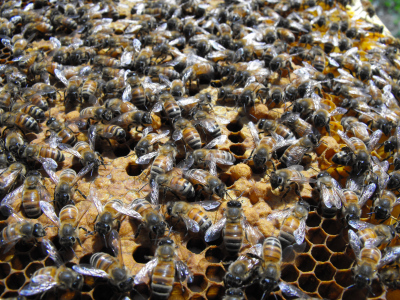
Spring swarm prevention and honey equalization
 In
the last week and a half, our three beehives have been churning out the
babies. Last time I checked on them, two hives
had a little bit of brood,
but now all three hives have brood of all ages on several frames.
They're also packing away pollen like nobody's business, and are
starting to dehydrate nectar into new honey. None of them have
started using the second super yet, though --- maybe once the fruit
trees and dandelions really start blooming.
In
the last week and a half, our three beehives have been churning out the
babies. Last time I checked on them, two hives
had a little bit of brood,
but now all three hives have brood of all ages on several frames.
They're also packing away pollen like nobody's business, and are
starting to dehydrate nectar into new honey. None of them have
started using the second super yet, though --- maybe once the fruit
trees and dandelions really start blooming.
In other pleasant news,
the raised brood cell that I thought might be
an incipient queen cup in one hive earlier in March turned into a bit
of drone brood (the few bumps in the photo above), which means I
haven't crowded the hive too much. I went ahead and opened all of
the brood boxes up, though, to stave off any feelings of overcrowding
in the near future. "Opening up the brood box" sounds confusing,
but it's actually quite simple --- just take the empty frames that
naturally gravitate to the sides of the box and intersperse them
between frames full of brood and pollen. As you leaf through the
opened brood box from one end to the other, it now reads "empty, full,
empty, full, empty, full, empty, full, empty, full" rather than "empty,
empty, full, full, full, full, full, empty, empty, empty." The
theory is that if the queen has empty frames near her, she won't think
she's running out of space, so she won't instigate a swarm. Hives
that don't swarm produce a lot more honey, so swarm prevention is key
to getting a good harvest.
In February, I got
concerned that our two weaker hives might be running low on honey,
so I stole three frames from the strongest hive to give them
backup. When I checked this week, though, the strongest hive had
eaten nearly every drop of its copious honey, presumably fueling the
huge egg-laying campaign it has embarked on. So I moved two small
frames of honey back from one
of the weaker hives to the strongest hive. This type of maneuver
is a sure sign of a far-too-hands-on beekeeper, but I can't help being
a nervous nellie about our livestock.
Want more in-depth information? Browse through our books.
Or explore more posts by date or by subject.
About us: Anna Hess and Mark Hamilton spent over a decade living self-sufficiently in the mountains of Virginia before moving north to start over from scratch in the foothills of Ohio. They've experimented with permaculture, no-till gardening, trailersteading, home-based microbusinesses and much more, writing about their adventures in both blogs and books.
Want to be notified when new comments are posted on this page? Click on the RSS button after you add a comment to subscribe to the comment feed, or simply check the box beside "email replies to me" while writing your comment.
